Women Participation is Less Compared to Men in Taxi Drivers: A Brief Study on UBER Company
VerifiedAdded on 2023/06/11
|15
|3796
|65
AI Summary
This study investigates the causes of fewer women participation in the transportation service providing industry as the cab drivers, with a case study on UBER Company. It discusses biased performance appraisal, poor wage distribution, long-working hours, negative perception, and workplace harassment.
Contribute Materials
Your contribution can guide someone’s learning journey. Share your
documents today.
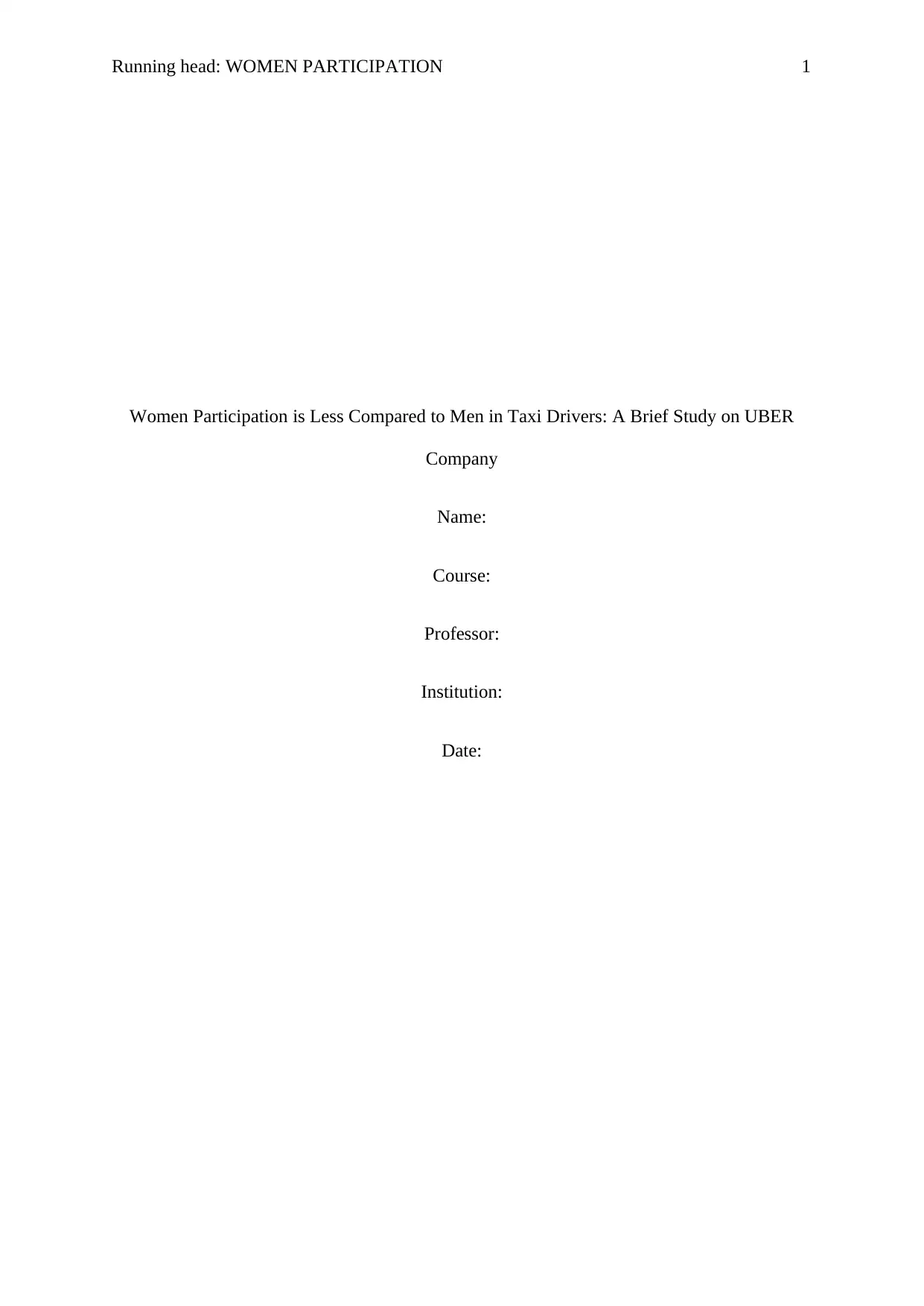
Running head: WOMEN PARTICIPATION 1
Women Participation is Less Compared to Men in Taxi Drivers: A Brief Study on UBER
Company
Name:
Course:
Professor:
Institution:
Date:
Women Participation is Less Compared to Men in Taxi Drivers: A Brief Study on UBER
Company
Name:
Course:
Professor:
Institution:
Date:
Secure Best Marks with AI Grader
Need help grading? Try our AI Grader for instant feedback on your assignments.
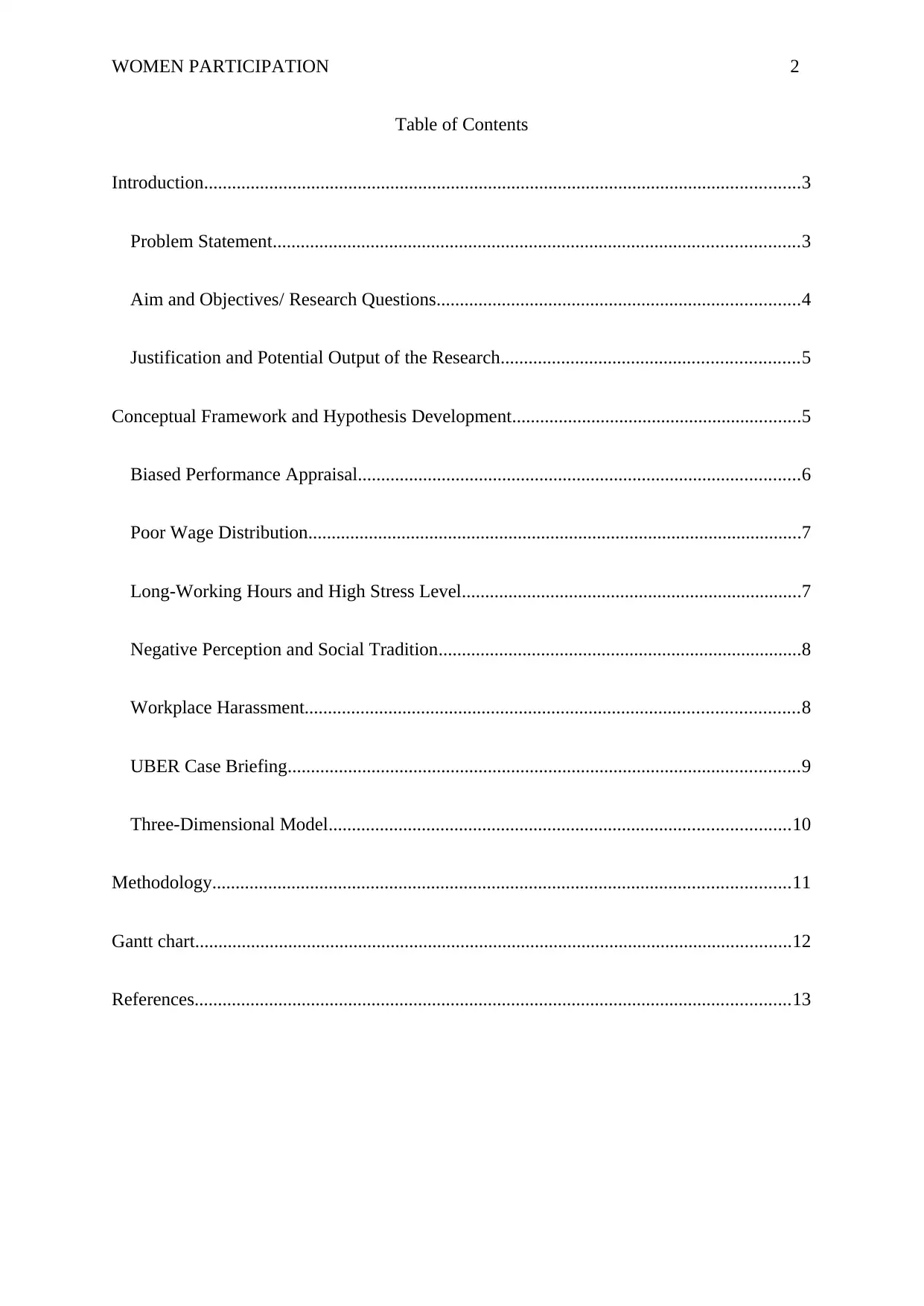
WOMEN PARTICIPATION 2
Table of Contents
Introduction................................................................................................................................3
Problem Statement.................................................................................................................3
Aim and Objectives/ Research Questions..............................................................................4
Justification and Potential Output of the Research................................................................5
Conceptual Framework and Hypothesis Development..............................................................5
Biased Performance Appraisal...............................................................................................6
Poor Wage Distribution..........................................................................................................7
Long-Working Hours and High Stress Level.........................................................................7
Negative Perception and Social Tradition..............................................................................8
Workplace Harassment..........................................................................................................8
UBER Case Briefing..............................................................................................................9
Three-Dimensional Model...................................................................................................10
Methodology............................................................................................................................11
Gantt chart................................................................................................................................12
References................................................................................................................................13
Table of Contents
Introduction................................................................................................................................3
Problem Statement.................................................................................................................3
Aim and Objectives/ Research Questions..............................................................................4
Justification and Potential Output of the Research................................................................5
Conceptual Framework and Hypothesis Development..............................................................5
Biased Performance Appraisal...............................................................................................6
Poor Wage Distribution..........................................................................................................7
Long-Working Hours and High Stress Level.........................................................................7
Negative Perception and Social Tradition..............................................................................8
Workplace Harassment..........................................................................................................8
UBER Case Briefing..............................................................................................................9
Three-Dimensional Model...................................................................................................10
Methodology............................................................................................................................11
Gantt chart................................................................................................................................12
References................................................................................................................................13
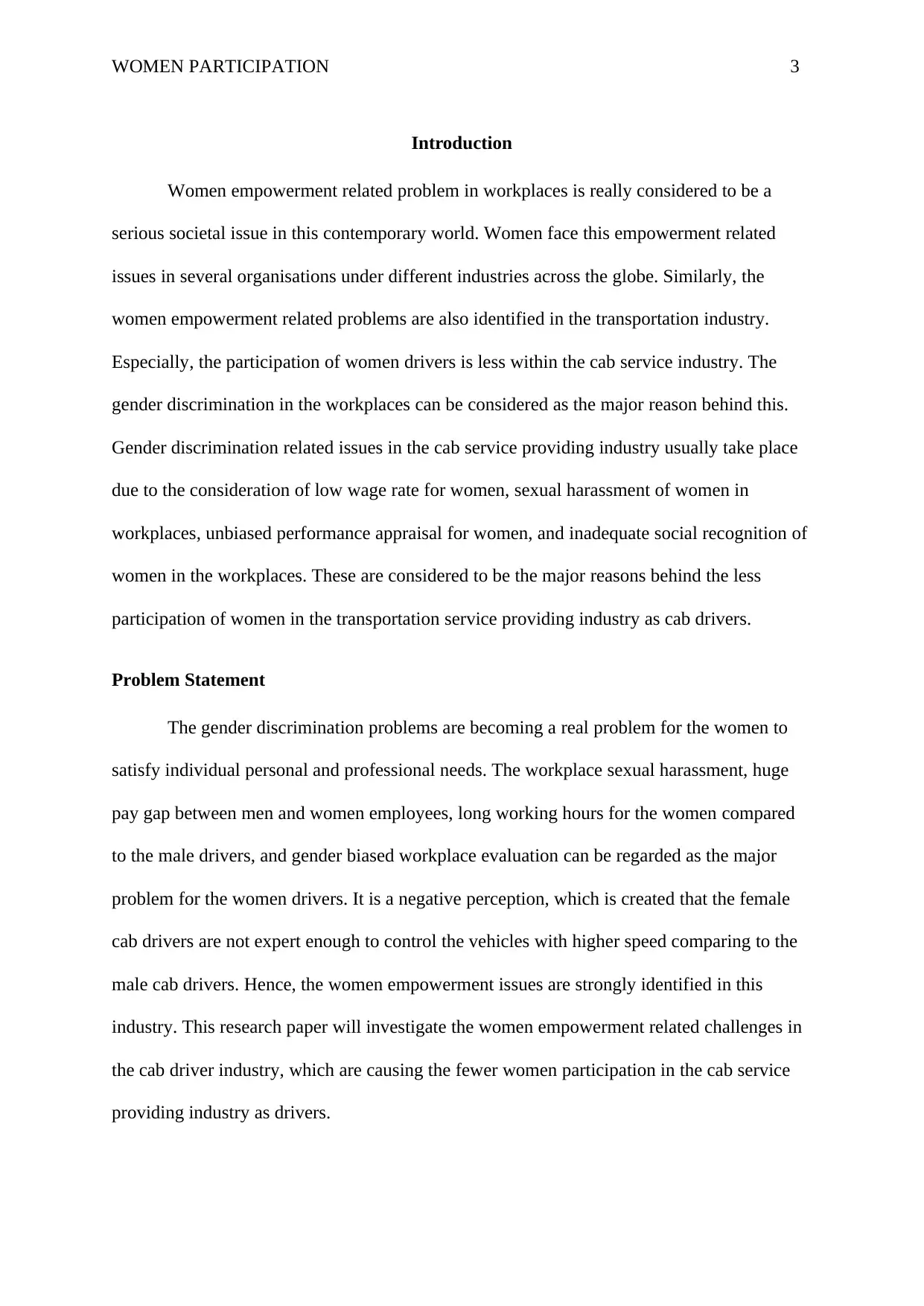
WOMEN PARTICIPATION 3
Introduction
Women empowerment related problem in workplaces is really considered to be a
serious societal issue in this contemporary world. Women face this empowerment related
issues in several organisations under different industries across the globe. Similarly, the
women empowerment related problems are also identified in the transportation industry.
Especially, the participation of women drivers is less within the cab service industry. The
gender discrimination in the workplaces can be considered as the major reason behind this.
Gender discrimination related issues in the cab service providing industry usually take place
due to the consideration of low wage rate for women, sexual harassment of women in
workplaces, unbiased performance appraisal for women, and inadequate social recognition of
women in the workplaces. These are considered to be the major reasons behind the less
participation of women in the transportation service providing industry as cab drivers.
Problem Statement
The gender discrimination problems are becoming a real problem for the women to
satisfy individual personal and professional needs. The workplace sexual harassment, huge
pay gap between men and women employees, long working hours for the women compared
to the male drivers, and gender biased workplace evaluation can be regarded as the major
problem for the women drivers. It is a negative perception, which is created that the female
cab drivers are not expert enough to control the vehicles with higher speed comparing to the
male cab drivers. Hence, the women empowerment issues are strongly identified in this
industry. This research paper will investigate the women empowerment related challenges in
the cab driver industry, which are causing the fewer women participation in the cab service
providing industry as drivers.
Introduction
Women empowerment related problem in workplaces is really considered to be a
serious societal issue in this contemporary world. Women face this empowerment related
issues in several organisations under different industries across the globe. Similarly, the
women empowerment related problems are also identified in the transportation industry.
Especially, the participation of women drivers is less within the cab service industry. The
gender discrimination in the workplaces can be considered as the major reason behind this.
Gender discrimination related issues in the cab service providing industry usually take place
due to the consideration of low wage rate for women, sexual harassment of women in
workplaces, unbiased performance appraisal for women, and inadequate social recognition of
women in the workplaces. These are considered to be the major reasons behind the less
participation of women in the transportation service providing industry as cab drivers.
Problem Statement
The gender discrimination problems are becoming a real problem for the women to
satisfy individual personal and professional needs. The workplace sexual harassment, huge
pay gap between men and women employees, long working hours for the women compared
to the male drivers, and gender biased workplace evaluation can be regarded as the major
problem for the women drivers. It is a negative perception, which is created that the female
cab drivers are not expert enough to control the vehicles with higher speed comparing to the
male cab drivers. Hence, the women empowerment issues are strongly identified in this
industry. This research paper will investigate the women empowerment related challenges in
the cab driver industry, which are causing the fewer women participation in the cab service
providing industry as drivers.
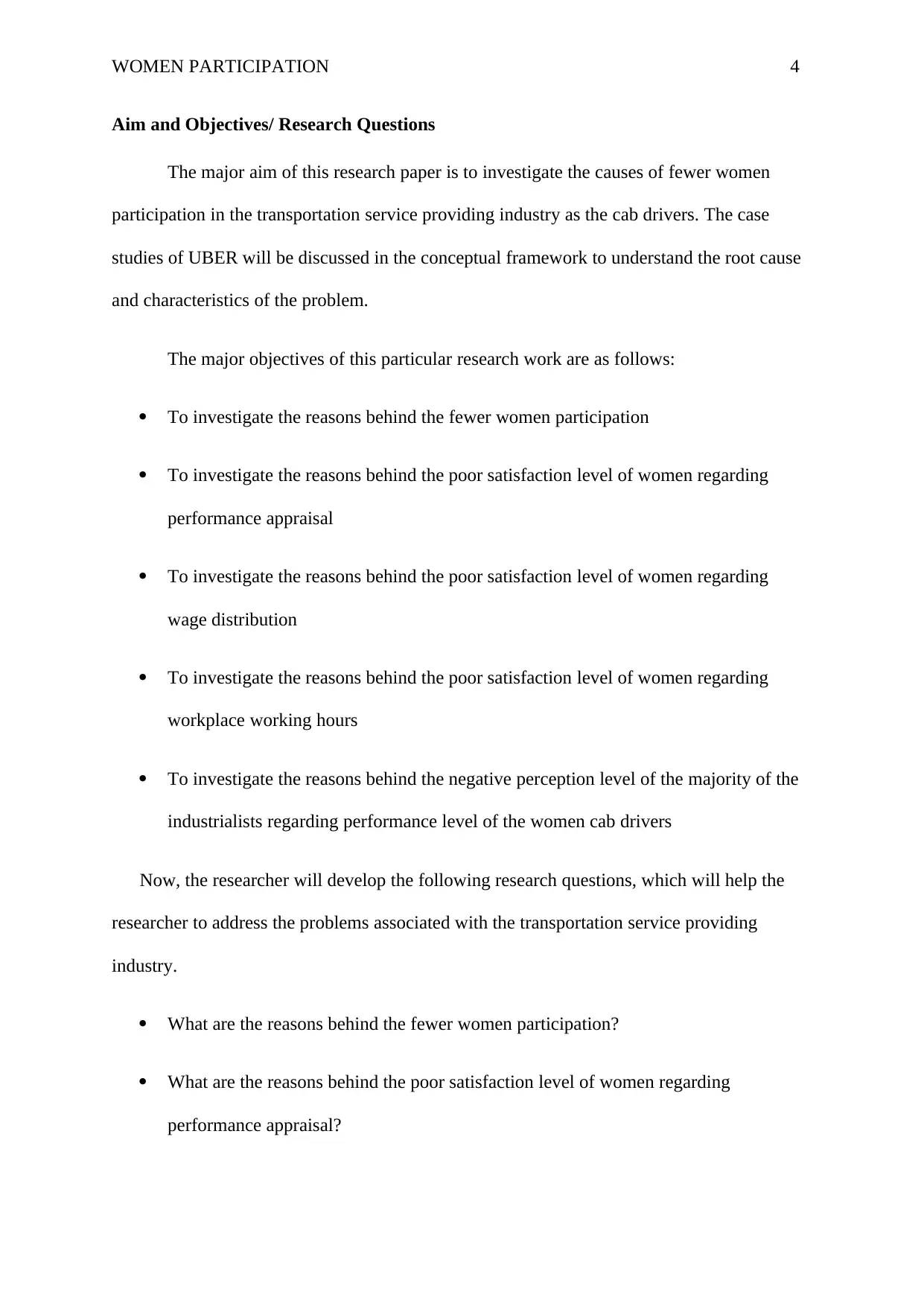
WOMEN PARTICIPATION 4
Aim and Objectives/ Research Questions
The major aim of this research paper is to investigate the causes of fewer women
participation in the transportation service providing industry as the cab drivers. The case
studies of UBER will be discussed in the conceptual framework to understand the root cause
and characteristics of the problem.
The major objectives of this particular research work are as follows:
To investigate the reasons behind the fewer women participation
To investigate the reasons behind the poor satisfaction level of women regarding
performance appraisal
To investigate the reasons behind the poor satisfaction level of women regarding
wage distribution
To investigate the reasons behind the poor satisfaction level of women regarding
workplace working hours
To investigate the reasons behind the negative perception level of the majority of the
industrialists regarding performance level of the women cab drivers
Now, the researcher will develop the following research questions, which will help the
researcher to address the problems associated with the transportation service providing
industry.
What are the reasons behind the fewer women participation?
What are the reasons behind the poor satisfaction level of women regarding
performance appraisal?
Aim and Objectives/ Research Questions
The major aim of this research paper is to investigate the causes of fewer women
participation in the transportation service providing industry as the cab drivers. The case
studies of UBER will be discussed in the conceptual framework to understand the root cause
and characteristics of the problem.
The major objectives of this particular research work are as follows:
To investigate the reasons behind the fewer women participation
To investigate the reasons behind the poor satisfaction level of women regarding
performance appraisal
To investigate the reasons behind the poor satisfaction level of women regarding
wage distribution
To investigate the reasons behind the poor satisfaction level of women regarding
workplace working hours
To investigate the reasons behind the negative perception level of the majority of the
industrialists regarding performance level of the women cab drivers
Now, the researcher will develop the following research questions, which will help the
researcher to address the problems associated with the transportation service providing
industry.
What are the reasons behind the fewer women participation?
What are the reasons behind the poor satisfaction level of women regarding
performance appraisal?
Secure Best Marks with AI Grader
Need help grading? Try our AI Grader for instant feedback on your assignments.
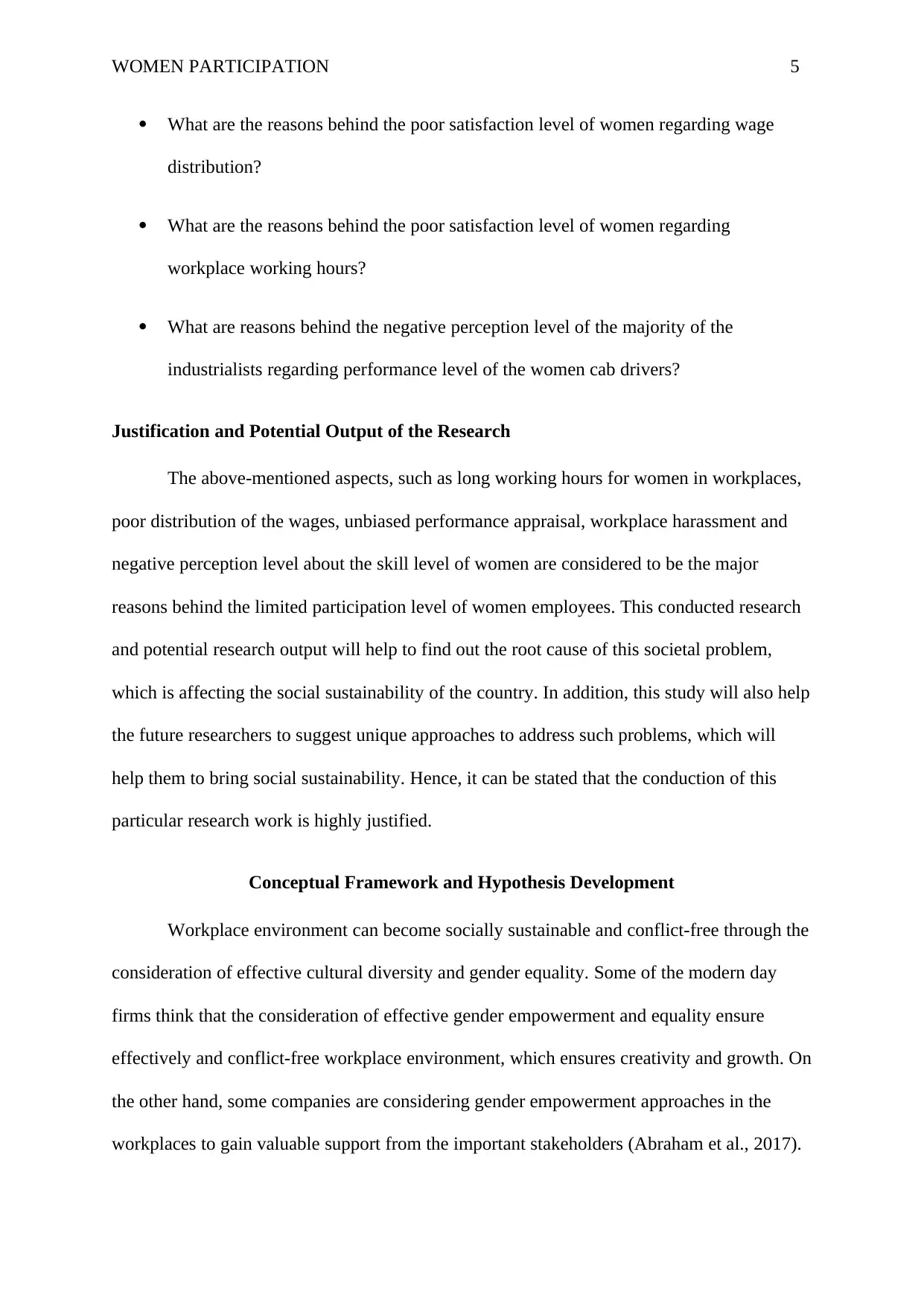
WOMEN PARTICIPATION 5
What are the reasons behind the poor satisfaction level of women regarding wage
distribution?
What are the reasons behind the poor satisfaction level of women regarding
workplace working hours?
What are reasons behind the negative perception level of the majority of the
industrialists regarding performance level of the women cab drivers?
Justification and Potential Output of the Research
The above-mentioned aspects, such as long working hours for women in workplaces,
poor distribution of the wages, unbiased performance appraisal, workplace harassment and
negative perception level about the skill level of women are considered to be the major
reasons behind the limited participation level of women employees. This conducted research
and potential research output will help to find out the root cause of this societal problem,
which is affecting the social sustainability of the country. In addition, this study will also help
the future researchers to suggest unique approaches to address such problems, which will
help them to bring social sustainability. Hence, it can be stated that the conduction of this
particular research work is highly justified.
Conceptual Framework and Hypothesis Development
Workplace environment can become socially sustainable and conflict-free through the
consideration of effective cultural diversity and gender equality. Some of the modern day
firms think that the consideration of effective gender empowerment and equality ensure
effectively and conflict-free workplace environment, which ensures creativity and growth. On
the other hand, some companies are considering gender empowerment approaches in the
workplaces to gain valuable support from the important stakeholders (Abraham et al., 2017).
What are the reasons behind the poor satisfaction level of women regarding wage
distribution?
What are the reasons behind the poor satisfaction level of women regarding
workplace working hours?
What are reasons behind the negative perception level of the majority of the
industrialists regarding performance level of the women cab drivers?
Justification and Potential Output of the Research
The above-mentioned aspects, such as long working hours for women in workplaces,
poor distribution of the wages, unbiased performance appraisal, workplace harassment and
negative perception level about the skill level of women are considered to be the major
reasons behind the limited participation level of women employees. This conducted research
and potential research output will help to find out the root cause of this societal problem,
which is affecting the social sustainability of the country. In addition, this study will also help
the future researchers to suggest unique approaches to address such problems, which will
help them to bring social sustainability. Hence, it can be stated that the conduction of this
particular research work is highly justified.
Conceptual Framework and Hypothesis Development
Workplace environment can become socially sustainable and conflict-free through the
consideration of effective cultural diversity and gender equality. Some of the modern day
firms think that the consideration of effective gender empowerment and equality ensure
effectively and conflict-free workplace environment, which ensures creativity and growth. On
the other hand, some companies are considering gender empowerment approaches in the
workplaces to gain valuable support from the important stakeholders (Abraham et al., 2017).
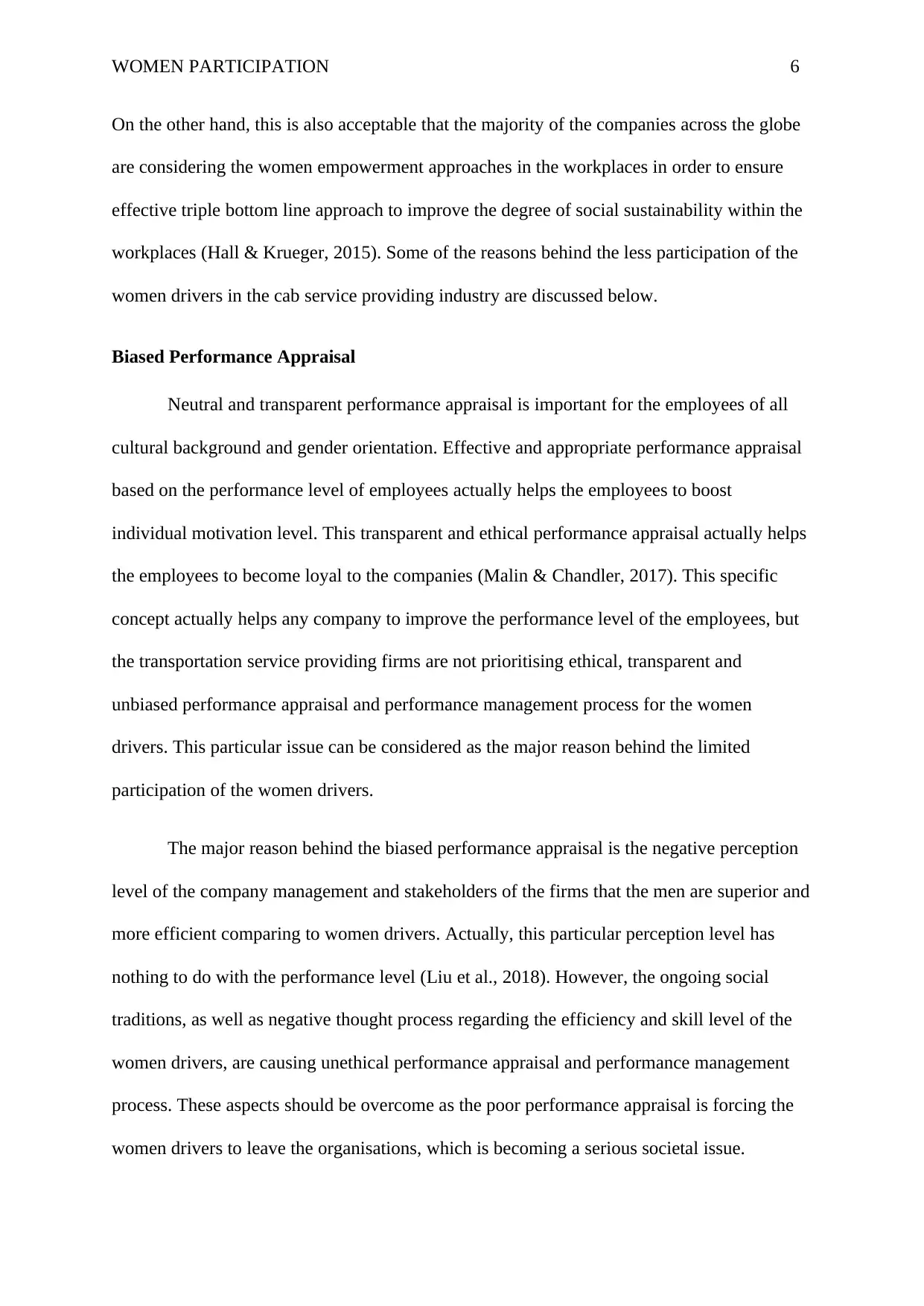
WOMEN PARTICIPATION 6
On the other hand, this is also acceptable that the majority of the companies across the globe
are considering the women empowerment approaches in the workplaces in order to ensure
effective triple bottom line approach to improve the degree of social sustainability within the
workplaces (Hall & Krueger, 2015). Some of the reasons behind the less participation of the
women drivers in the cab service providing industry are discussed below.
Biased Performance Appraisal
Neutral and transparent performance appraisal is important for the employees of all
cultural background and gender orientation. Effective and appropriate performance appraisal
based on the performance level of employees actually helps the employees to boost
individual motivation level. This transparent and ethical performance appraisal actually helps
the employees to become loyal to the companies (Malin & Chandler, 2017). This specific
concept actually helps any company to improve the performance level of the employees, but
the transportation service providing firms are not prioritising ethical, transparent and
unbiased performance appraisal and performance management process for the women
drivers. This particular issue can be considered as the major reason behind the limited
participation of the women drivers.
The major reason behind the biased performance appraisal is the negative perception
level of the company management and stakeholders of the firms that the men are superior and
more efficient comparing to women drivers. Actually, this particular perception level has
nothing to do with the performance level (Liu et al., 2018). However, the ongoing social
traditions, as well as negative thought process regarding the efficiency and skill level of the
women drivers, are causing unethical performance appraisal and performance management
process. These aspects should be overcome as the poor performance appraisal is forcing the
women drivers to leave the organisations, which is becoming a serious societal issue.
On the other hand, this is also acceptable that the majority of the companies across the globe
are considering the women empowerment approaches in the workplaces in order to ensure
effective triple bottom line approach to improve the degree of social sustainability within the
workplaces (Hall & Krueger, 2015). Some of the reasons behind the less participation of the
women drivers in the cab service providing industry are discussed below.
Biased Performance Appraisal
Neutral and transparent performance appraisal is important for the employees of all
cultural background and gender orientation. Effective and appropriate performance appraisal
based on the performance level of employees actually helps the employees to boost
individual motivation level. This transparent and ethical performance appraisal actually helps
the employees to become loyal to the companies (Malin & Chandler, 2017). This specific
concept actually helps any company to improve the performance level of the employees, but
the transportation service providing firms are not prioritising ethical, transparent and
unbiased performance appraisal and performance management process for the women
drivers. This particular issue can be considered as the major reason behind the limited
participation of the women drivers.
The major reason behind the biased performance appraisal is the negative perception
level of the company management and stakeholders of the firms that the men are superior and
more efficient comparing to women drivers. Actually, this particular perception level has
nothing to do with the performance level (Liu et al., 2018). However, the ongoing social
traditions, as well as negative thought process regarding the efficiency and skill level of the
women drivers, are causing unethical performance appraisal and performance management
process. These aspects should be overcome as the poor performance appraisal is forcing the
women drivers to leave the organisations, which is becoming a serious societal issue.
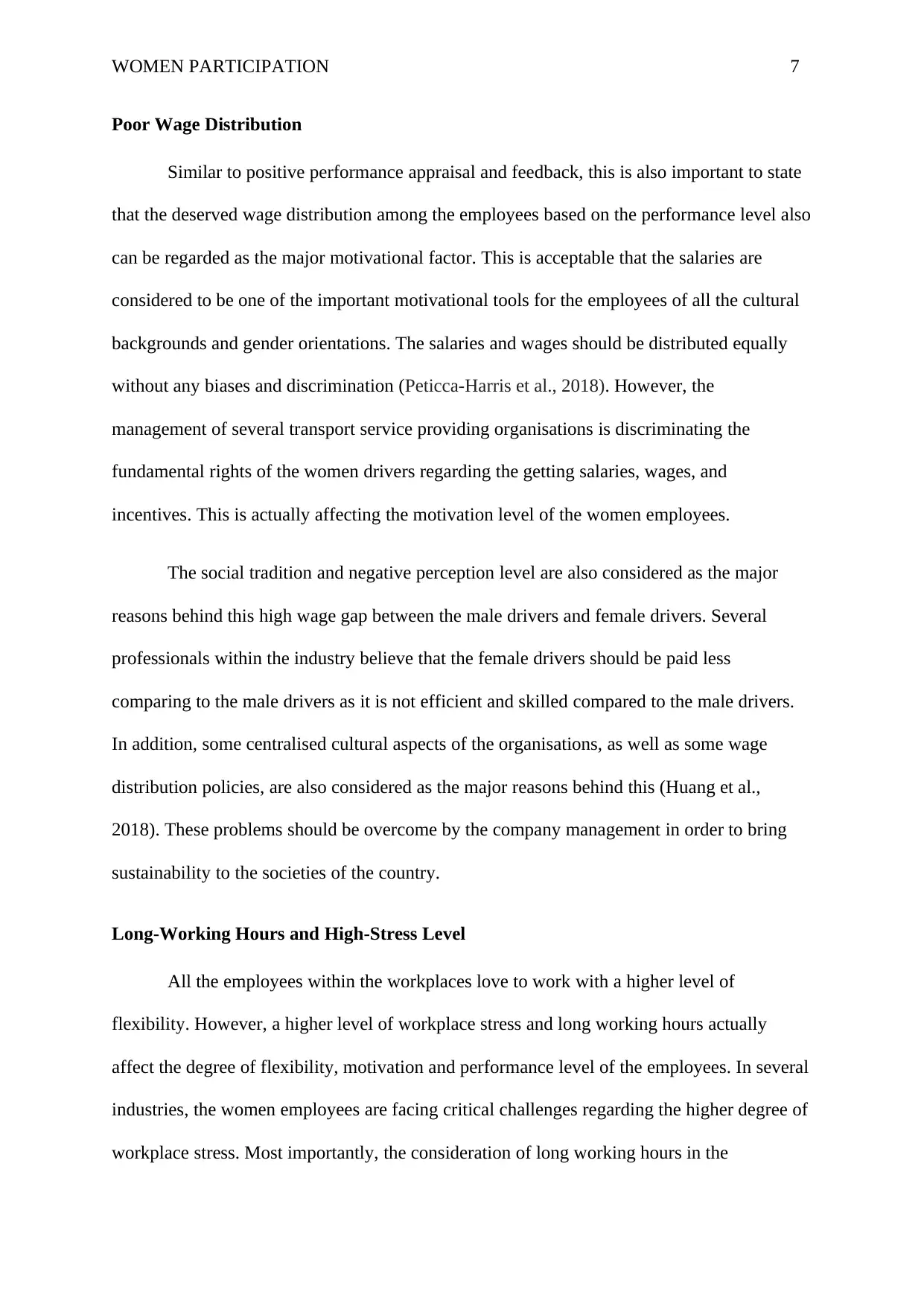
WOMEN PARTICIPATION 7
Poor Wage Distribution
Similar to positive performance appraisal and feedback, this is also important to state
that the deserved wage distribution among the employees based on the performance level also
can be regarded as the major motivational factor. This is acceptable that the salaries are
considered to be one of the important motivational tools for the employees of all the cultural
backgrounds and gender orientations. The salaries and wages should be distributed equally
without any biases and discrimination (Peticca-Harris et al., 2018). However, the
management of several transport service providing organisations is discriminating the
fundamental rights of the women drivers regarding the getting salaries, wages, and
incentives. This is actually affecting the motivation level of the women employees.
The social tradition and negative perception level are also considered as the major
reasons behind this high wage gap between the male drivers and female drivers. Several
professionals within the industry believe that the female drivers should be paid less
comparing to the male drivers as it is not efficient and skilled compared to the male drivers.
In addition, some centralised cultural aspects of the organisations, as well as some wage
distribution policies, are also considered as the major reasons behind this (Huang et al.,
2018). These problems should be overcome by the company management in order to bring
sustainability to the societies of the country.
Long-Working Hours and High-Stress Level
All the employees within the workplaces love to work with a higher level of
flexibility. However, a higher level of workplace stress and long working hours actually
affect the degree of flexibility, motivation and performance level of the employees. In several
industries, the women employees are facing critical challenges regarding the higher degree of
workplace stress. Most importantly, the consideration of long working hours in the
Poor Wage Distribution
Similar to positive performance appraisal and feedback, this is also important to state
that the deserved wage distribution among the employees based on the performance level also
can be regarded as the major motivational factor. This is acceptable that the salaries are
considered to be one of the important motivational tools for the employees of all the cultural
backgrounds and gender orientations. The salaries and wages should be distributed equally
without any biases and discrimination (Peticca-Harris et al., 2018). However, the
management of several transport service providing organisations is discriminating the
fundamental rights of the women drivers regarding the getting salaries, wages, and
incentives. This is actually affecting the motivation level of the women employees.
The social tradition and negative perception level are also considered as the major
reasons behind this high wage gap between the male drivers and female drivers. Several
professionals within the industry believe that the female drivers should be paid less
comparing to the male drivers as it is not efficient and skilled compared to the male drivers.
In addition, some centralised cultural aspects of the organisations, as well as some wage
distribution policies, are also considered as the major reasons behind this (Huang et al.,
2018). These problems should be overcome by the company management in order to bring
sustainability to the societies of the country.
Long-Working Hours and High-Stress Level
All the employees within the workplaces love to work with a higher level of
flexibility. However, a higher level of workplace stress and long working hours actually
affect the degree of flexibility, motivation and performance level of the employees. In several
industries, the women employees are facing critical challenges regarding the higher degree of
workplace stress. Most importantly, the consideration of long working hours in the
Paraphrase This Document
Need a fresh take? Get an instant paraphrase of this document with our AI Paraphraser
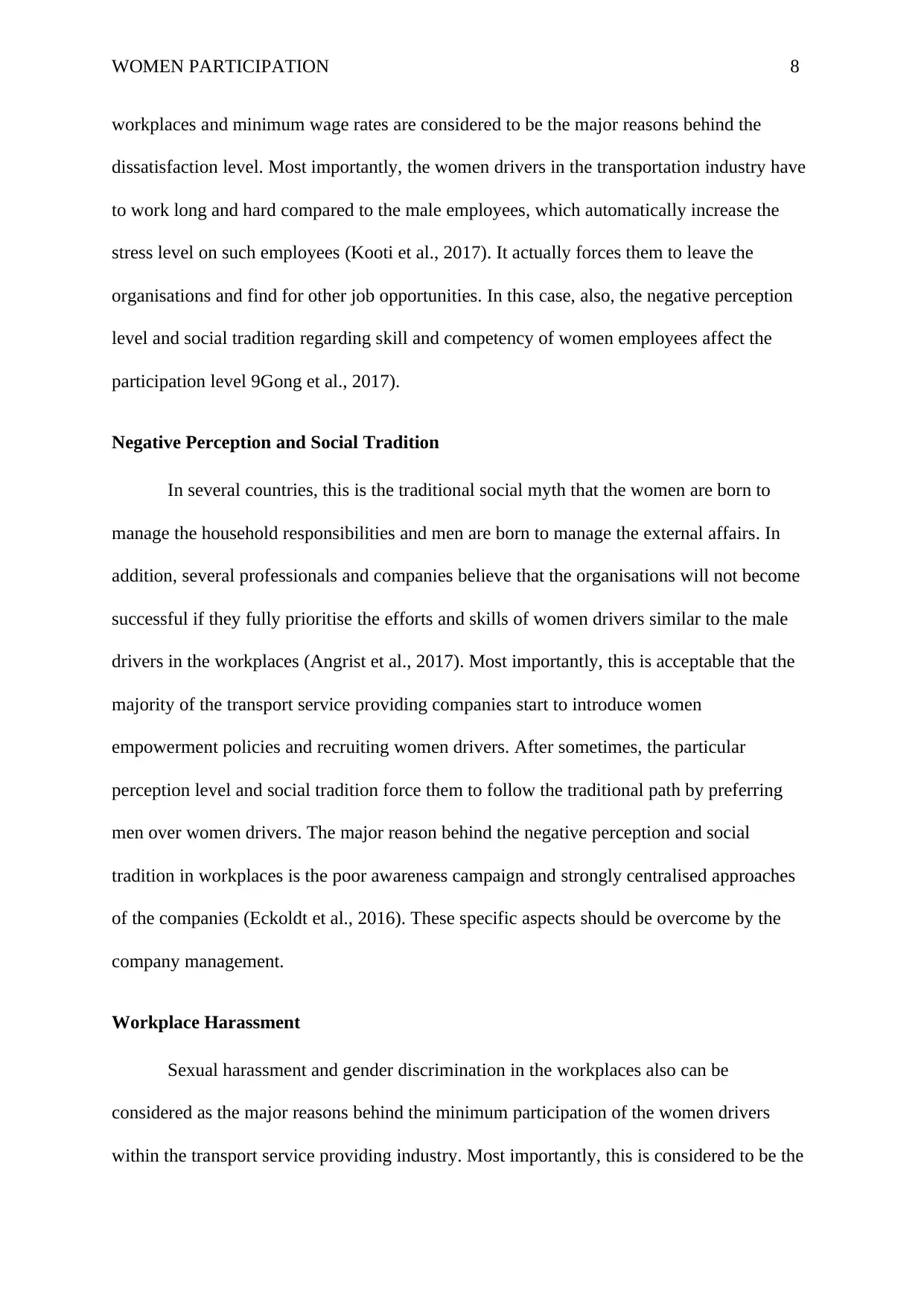
WOMEN PARTICIPATION 8
workplaces and minimum wage rates are considered to be the major reasons behind the
dissatisfaction level. Most importantly, the women drivers in the transportation industry have
to work long and hard compared to the male employees, which automatically increase the
stress level on such employees (Kooti et al., 2017). It actually forces them to leave the
organisations and find for other job opportunities. In this case, also, the negative perception
level and social tradition regarding skill and competency of women employees affect the
participation level 9Gong et al., 2017).
Negative Perception and Social Tradition
In several countries, this is the traditional social myth that the women are born to
manage the household responsibilities and men are born to manage the external affairs. In
addition, several professionals and companies believe that the organisations will not become
successful if they fully prioritise the efforts and skills of women drivers similar to the male
drivers in the workplaces (Angrist et al., 2017). Most importantly, this is acceptable that the
majority of the transport service providing companies start to introduce women
empowerment policies and recruiting women drivers. After sometimes, the particular
perception level and social tradition force them to follow the traditional path by preferring
men over women drivers. The major reason behind the negative perception and social
tradition in workplaces is the poor awareness campaign and strongly centralised approaches
of the companies (Eckoldt et al., 2016). These specific aspects should be overcome by the
company management.
Workplace Harassment
Sexual harassment and gender discrimination in the workplaces also can be
considered as the major reasons behind the minimum participation of the women drivers
within the transport service providing industry. Most importantly, this is considered to be the
workplaces and minimum wage rates are considered to be the major reasons behind the
dissatisfaction level. Most importantly, the women drivers in the transportation industry have
to work long and hard compared to the male employees, which automatically increase the
stress level on such employees (Kooti et al., 2017). It actually forces them to leave the
organisations and find for other job opportunities. In this case, also, the negative perception
level and social tradition regarding skill and competency of women employees affect the
participation level 9Gong et al., 2017).
Negative Perception and Social Tradition
In several countries, this is the traditional social myth that the women are born to
manage the household responsibilities and men are born to manage the external affairs. In
addition, several professionals and companies believe that the organisations will not become
successful if they fully prioritise the efforts and skills of women drivers similar to the male
drivers in the workplaces (Angrist et al., 2017). Most importantly, this is acceptable that the
majority of the transport service providing companies start to introduce women
empowerment policies and recruiting women drivers. After sometimes, the particular
perception level and social tradition force them to follow the traditional path by preferring
men over women drivers. The major reason behind the negative perception and social
tradition in workplaces is the poor awareness campaign and strongly centralised approaches
of the companies (Eckoldt et al., 2016). These specific aspects should be overcome by the
company management.
Workplace Harassment
Sexual harassment and gender discrimination in the workplaces also can be
considered as the major reasons behind the minimum participation of the women drivers
within the transport service providing industry. Most importantly, this is considered to be the
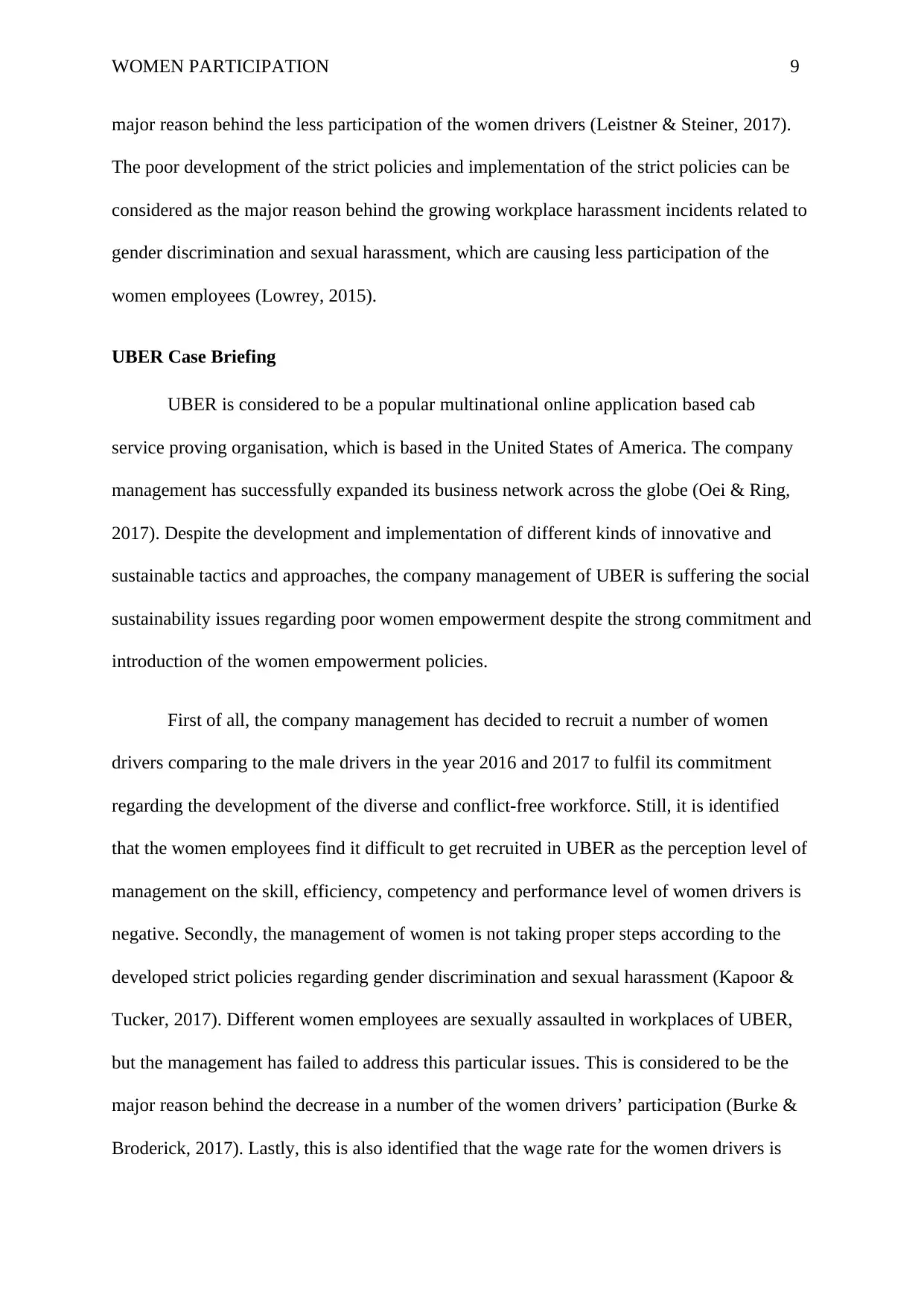
WOMEN PARTICIPATION 9
major reason behind the less participation of the women drivers (Leistner & Steiner, 2017).
The poor development of the strict policies and implementation of the strict policies can be
considered as the major reason behind the growing workplace harassment incidents related to
gender discrimination and sexual harassment, which are causing less participation of the
women employees (Lowrey, 2015).
UBER Case Briefing
UBER is considered to be a popular multinational online application based cab
service proving organisation, which is based in the United States of America. The company
management has successfully expanded its business network across the globe (Oei & Ring,
2017). Despite the development and implementation of different kinds of innovative and
sustainable tactics and approaches, the company management of UBER is suffering the social
sustainability issues regarding poor women empowerment despite the strong commitment and
introduction of the women empowerment policies.
First of all, the company management has decided to recruit a number of women
drivers comparing to the male drivers in the year 2016 and 2017 to fulfil its commitment
regarding the development of the diverse and conflict-free workforce. Still, it is identified
that the women employees find it difficult to get recruited in UBER as the perception level of
management on the skill, efficiency, competency and performance level of women drivers is
negative. Secondly, the management of women is not taking proper steps according to the
developed strict policies regarding gender discrimination and sexual harassment (Kapoor &
Tucker, 2017). Different women employees are sexually assaulted in workplaces of UBER,
but the management has failed to address this particular issues. This is considered to be the
major reason behind the decrease in a number of the women drivers’ participation (Burke &
Broderick, 2017). Lastly, this is also identified that the wage rate for the women drivers is
major reason behind the less participation of the women drivers (Leistner & Steiner, 2017).
The poor development of the strict policies and implementation of the strict policies can be
considered as the major reason behind the growing workplace harassment incidents related to
gender discrimination and sexual harassment, which are causing less participation of the
women employees (Lowrey, 2015).
UBER Case Briefing
UBER is considered to be a popular multinational online application based cab
service proving organisation, which is based in the United States of America. The company
management has successfully expanded its business network across the globe (Oei & Ring,
2017). Despite the development and implementation of different kinds of innovative and
sustainable tactics and approaches, the company management of UBER is suffering the social
sustainability issues regarding poor women empowerment despite the strong commitment and
introduction of the women empowerment policies.
First of all, the company management has decided to recruit a number of women
drivers comparing to the male drivers in the year 2016 and 2017 to fulfil its commitment
regarding the development of the diverse and conflict-free workforce. Still, it is identified
that the women employees find it difficult to get recruited in UBER as the perception level of
management on the skill, efficiency, competency and performance level of women drivers is
negative. Secondly, the management of women is not taking proper steps according to the
developed strict policies regarding gender discrimination and sexual harassment (Kapoor &
Tucker, 2017). Different women employees are sexually assaulted in workplaces of UBER,
but the management has failed to address this particular issues. This is considered to be the
major reason behind the decrease in a number of the women drivers’ participation (Burke &
Broderick, 2017). Lastly, this is also identified that the wage rate for the women drivers is
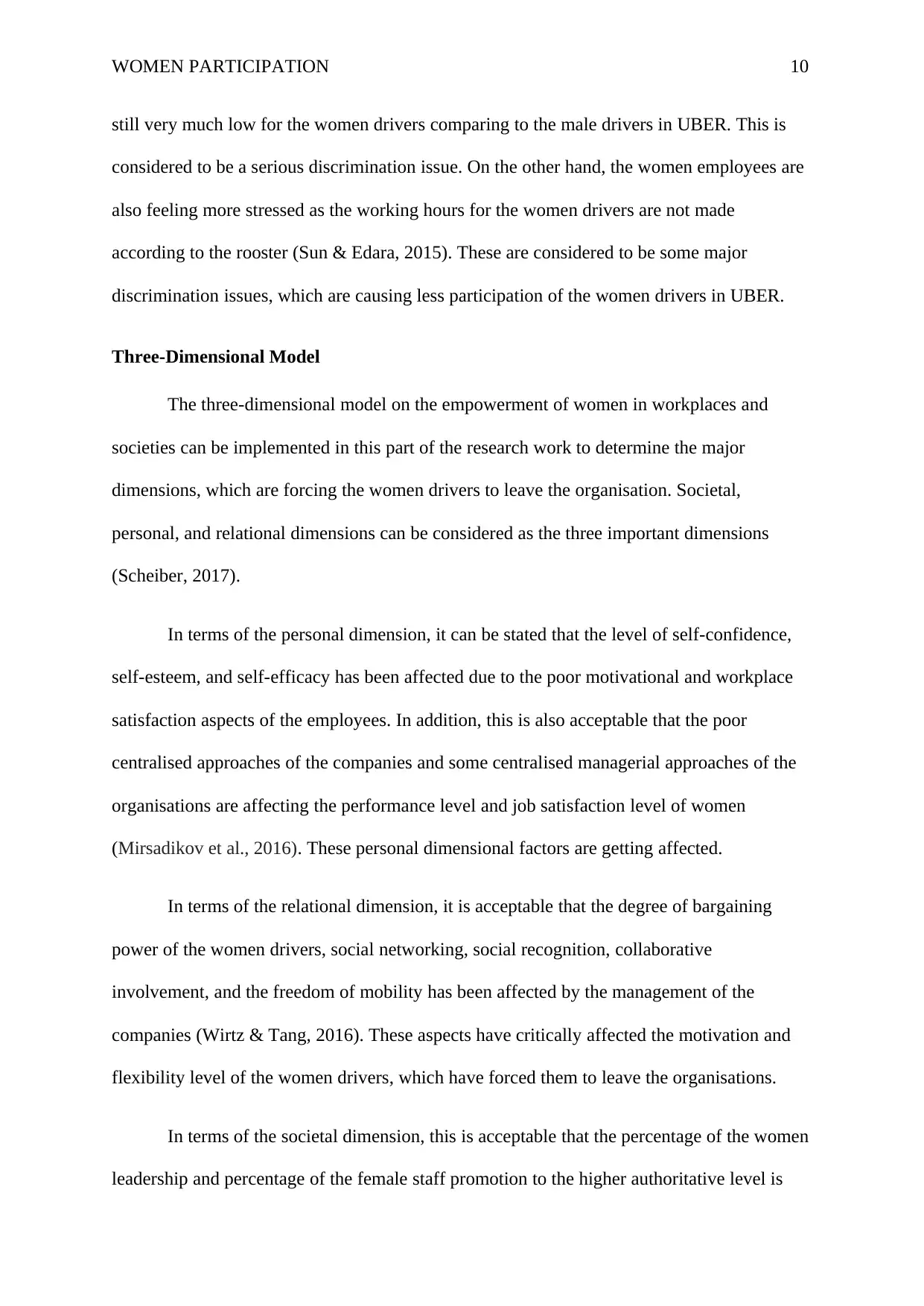
WOMEN PARTICIPATION 10
still very much low for the women drivers comparing to the male drivers in UBER. This is
considered to be a serious discrimination issue. On the other hand, the women employees are
also feeling more stressed as the working hours for the women drivers are not made
according to the rooster (Sun & Edara, 2015). These are considered to be some major
discrimination issues, which are causing less participation of the women drivers in UBER.
Three-Dimensional Model
The three-dimensional model on the empowerment of women in workplaces and
societies can be implemented in this part of the research work to determine the major
dimensions, which are forcing the women drivers to leave the organisation. Societal,
personal, and relational dimensions can be considered as the three important dimensions
(Scheiber, 2017).
In terms of the personal dimension, it can be stated that the level of self-confidence,
self-esteem, and self-efficacy has been affected due to the poor motivational and workplace
satisfaction aspects of the employees. In addition, this is also acceptable that the poor
centralised approaches of the companies and some centralised managerial approaches of the
organisations are affecting the performance level and job satisfaction level of women
(Mirsadikov et al., 2016). These personal dimensional factors are getting affected.
In terms of the relational dimension, it is acceptable that the degree of bargaining
power of the women drivers, social networking, social recognition, collaborative
involvement, and the freedom of mobility has been affected by the management of the
companies (Wirtz & Tang, 2016). These aspects have critically affected the motivation and
flexibility level of the women drivers, which have forced them to leave the organisations.
In terms of the societal dimension, this is acceptable that the percentage of the women
leadership and percentage of the female staff promotion to the higher authoritative level is
still very much low for the women drivers comparing to the male drivers in UBER. This is
considered to be a serious discrimination issue. On the other hand, the women employees are
also feeling more stressed as the working hours for the women drivers are not made
according to the rooster (Sun & Edara, 2015). These are considered to be some major
discrimination issues, which are causing less participation of the women drivers in UBER.
Three-Dimensional Model
The three-dimensional model on the empowerment of women in workplaces and
societies can be implemented in this part of the research work to determine the major
dimensions, which are forcing the women drivers to leave the organisation. Societal,
personal, and relational dimensions can be considered as the three important dimensions
(Scheiber, 2017).
In terms of the personal dimension, it can be stated that the level of self-confidence,
self-esteem, and self-efficacy has been affected due to the poor motivational and workplace
satisfaction aspects of the employees. In addition, this is also acceptable that the poor
centralised approaches of the companies and some centralised managerial approaches of the
organisations are affecting the performance level and job satisfaction level of women
(Mirsadikov et al., 2016). These personal dimensional factors are getting affected.
In terms of the relational dimension, it is acceptable that the degree of bargaining
power of the women drivers, social networking, social recognition, collaborative
involvement, and the freedom of mobility has been affected by the management of the
companies (Wirtz & Tang, 2016). These aspects have critically affected the motivation and
flexibility level of the women drivers, which have forced them to leave the organisations.
In terms of the societal dimension, this is acceptable that the percentage of the women
leadership and percentage of the female staff promotion to the higher authoritative level is
Secure Best Marks with AI Grader
Need help grading? Try our AI Grader for instant feedback on your assignments.
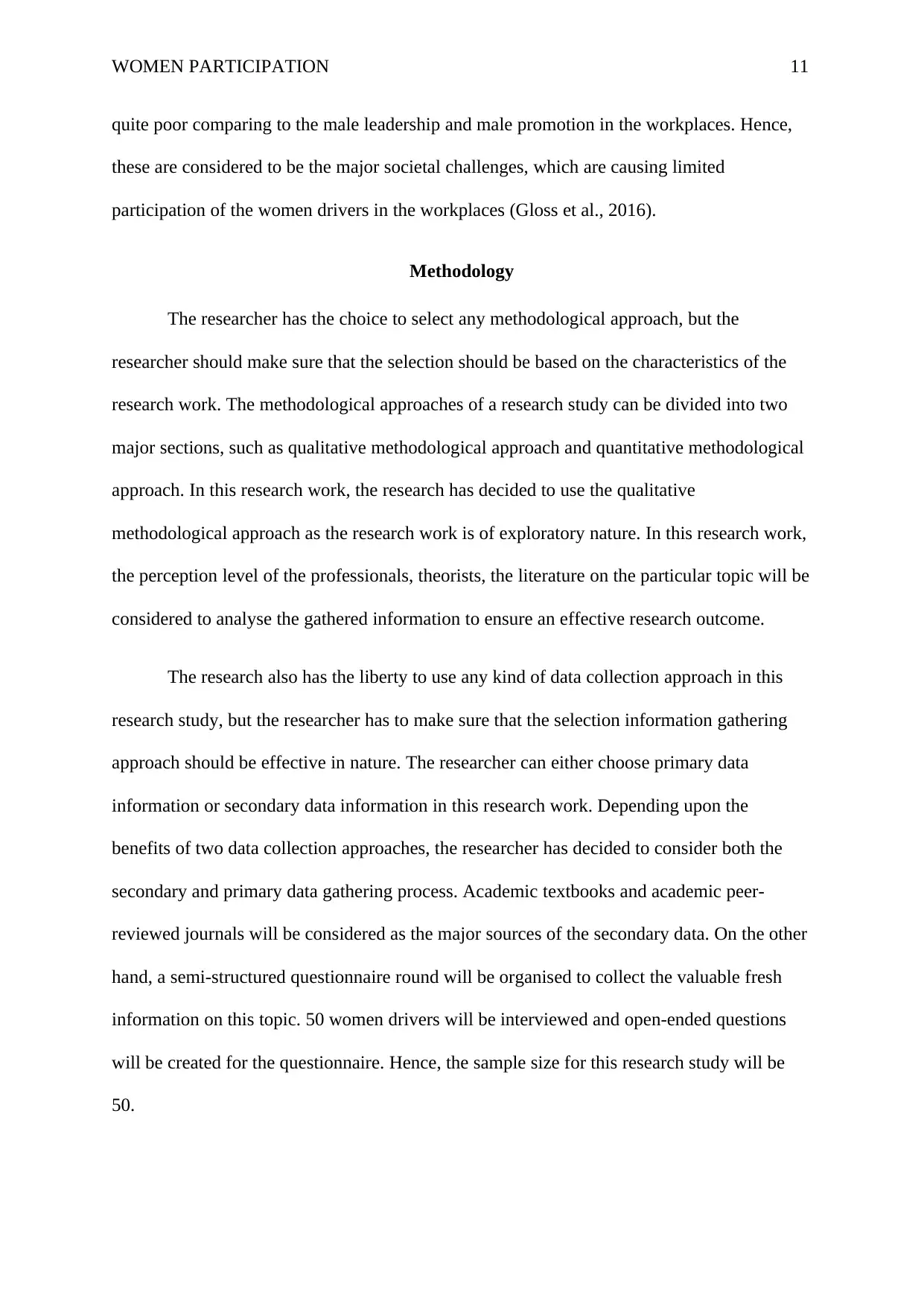
WOMEN PARTICIPATION 11
quite poor comparing to the male leadership and male promotion in the workplaces. Hence,
these are considered to be the major societal challenges, which are causing limited
participation of the women drivers in the workplaces (Gloss et al., 2016).
Methodology
The researcher has the choice to select any methodological approach, but the
researcher should make sure that the selection should be based on the characteristics of the
research work. The methodological approaches of a research study can be divided into two
major sections, such as qualitative methodological approach and quantitative methodological
approach. In this research work, the research has decided to use the qualitative
methodological approach as the research work is of exploratory nature. In this research work,
the perception level of the professionals, theorists, the literature on the particular topic will be
considered to analyse the gathered information to ensure an effective research outcome.
The research also has the liberty to use any kind of data collection approach in this
research study, but the researcher has to make sure that the selection information gathering
approach should be effective in nature. The researcher can either choose primary data
information or secondary data information in this research work. Depending upon the
benefits of two data collection approaches, the researcher has decided to consider both the
secondary and primary data gathering process. Academic textbooks and academic peer-
reviewed journals will be considered as the major sources of the secondary data. On the other
hand, a semi-structured questionnaire round will be organised to collect the valuable fresh
information on this topic. 50 women drivers will be interviewed and open-ended questions
will be created for the questionnaire. Hence, the sample size for this research study will be
50.
quite poor comparing to the male leadership and male promotion in the workplaces. Hence,
these are considered to be the major societal challenges, which are causing limited
participation of the women drivers in the workplaces (Gloss et al., 2016).
Methodology
The researcher has the choice to select any methodological approach, but the
researcher should make sure that the selection should be based on the characteristics of the
research work. The methodological approaches of a research study can be divided into two
major sections, such as qualitative methodological approach and quantitative methodological
approach. In this research work, the research has decided to use the qualitative
methodological approach as the research work is of exploratory nature. In this research work,
the perception level of the professionals, theorists, the literature on the particular topic will be
considered to analyse the gathered information to ensure an effective research outcome.
The research also has the liberty to use any kind of data collection approach in this
research study, but the researcher has to make sure that the selection information gathering
approach should be effective in nature. The researcher can either choose primary data
information or secondary data information in this research work. Depending upon the
benefits of two data collection approaches, the researcher has decided to consider both the
secondary and primary data gathering process. Academic textbooks and academic peer-
reviewed journals will be considered as the major sources of the secondary data. On the other
hand, a semi-structured questionnaire round will be organised to collect the valuable fresh
information on this topic. 50 women drivers will be interviewed and open-ended questions
will be created for the questionnaire. Hence, the sample size for this research study will be
50.
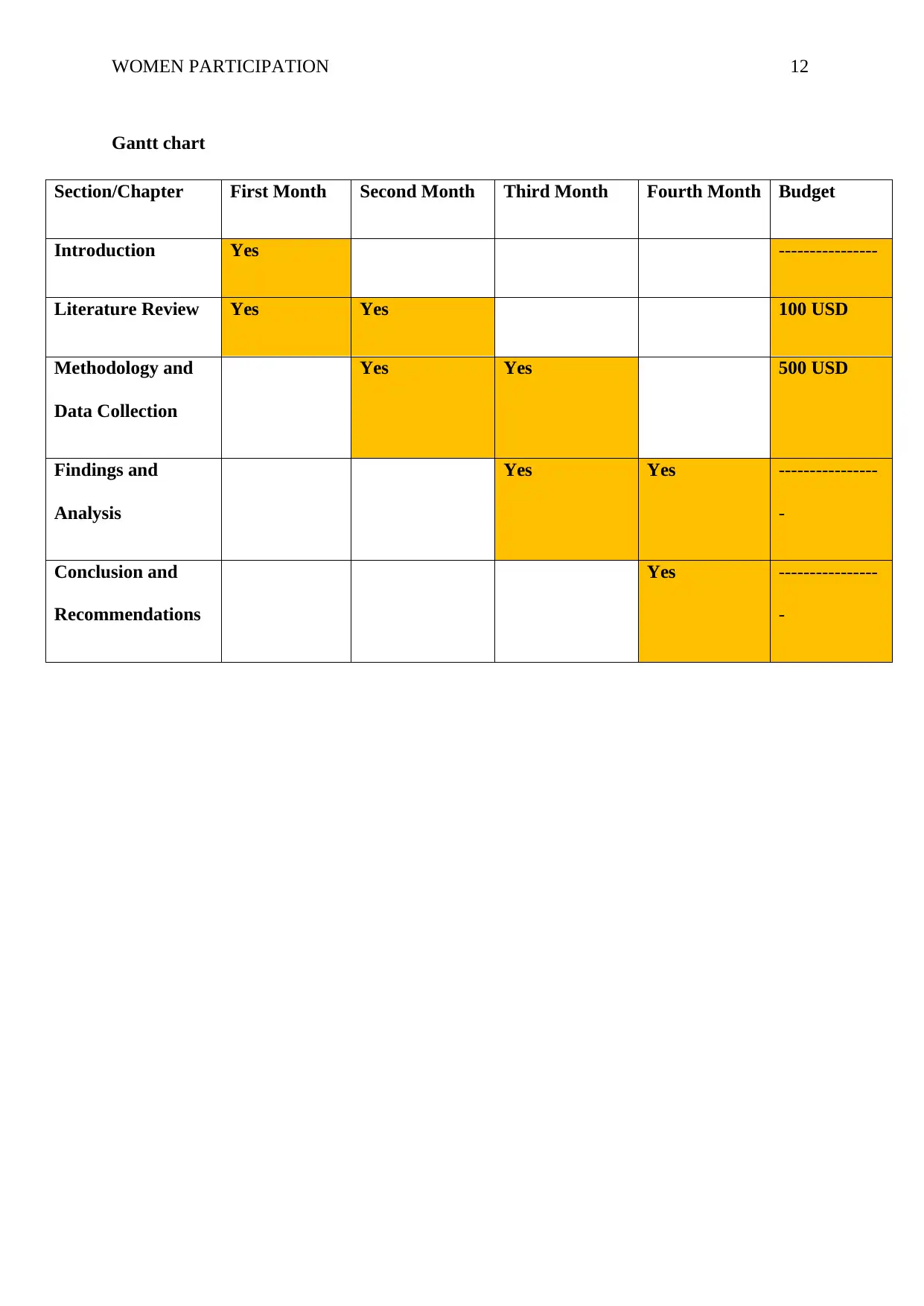
WOMEN PARTICIPATION 12
Gantt chart
Section/Chapter First Month Second Month Third Month Fourth Month Budget
Introduction Yes ----------------
Literature Review Yes Yes 100 USD
Methodology and
Data Collection
Yes Yes 500 USD
Findings and
Analysis
Yes Yes ----------------
-
Conclusion and
Recommendations
Yes ----------------
-
Gantt chart
Section/Chapter First Month Second Month Third Month Fourth Month Budget
Introduction Yes ----------------
Literature Review Yes Yes 100 USD
Methodology and
Data Collection
Yes Yes 500 USD
Findings and
Analysis
Yes Yes ----------------
-
Conclusion and
Recommendations
Yes ----------------
-
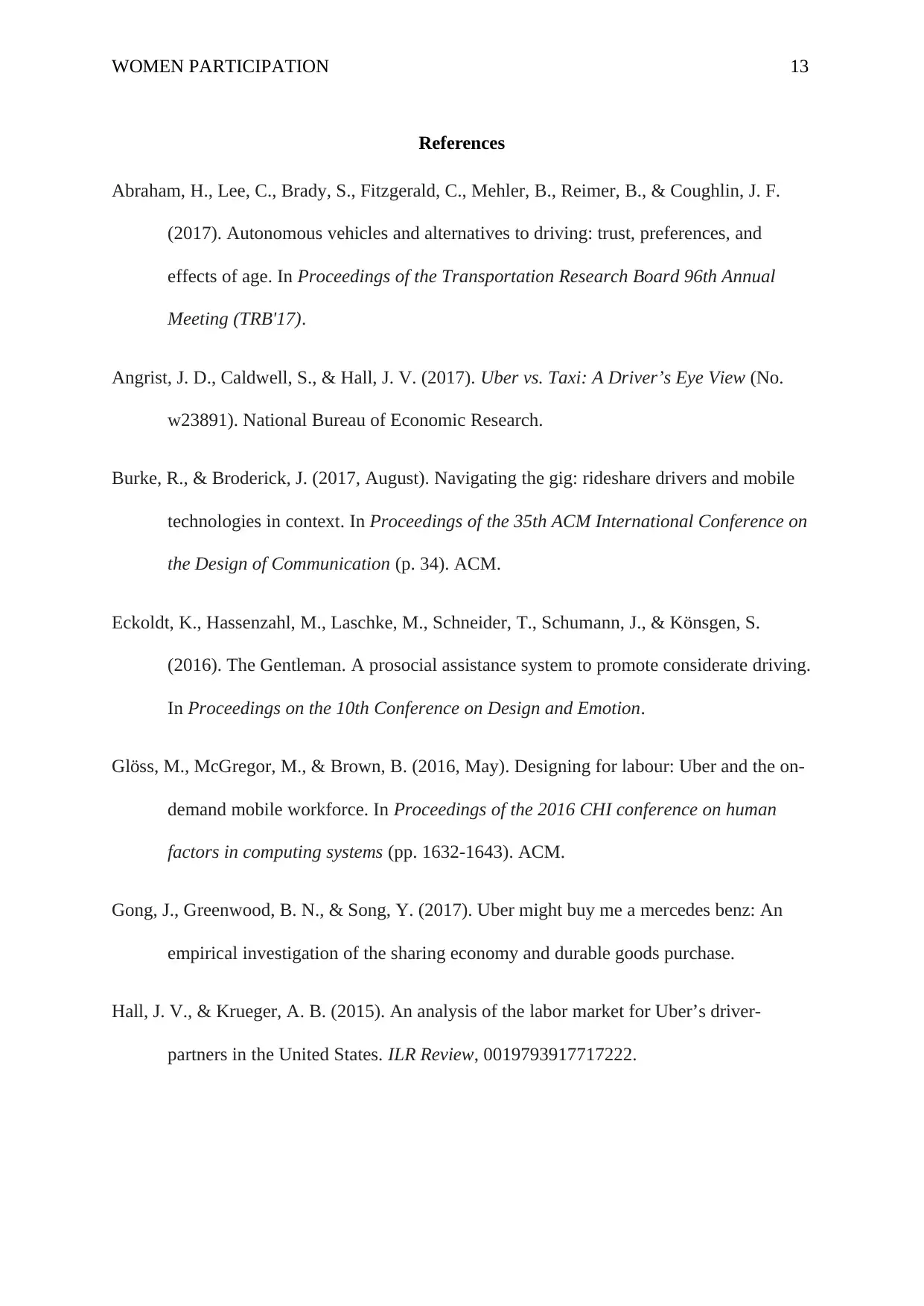
WOMEN PARTICIPATION 13
References
Abraham, H., Lee, C., Brady, S., Fitzgerald, C., Mehler, B., Reimer, B., & Coughlin, J. F.
(2017). Autonomous vehicles and alternatives to driving: trust, preferences, and
effects of age. In Proceedings of the Transportation Research Board 96th Annual
Meeting (TRB'17).
Angrist, J. D., Caldwell, S., & Hall, J. V. (2017). Uber vs. Taxi: A Driver’s Eye View (No.
w23891). National Bureau of Economic Research.
Burke, R., & Broderick, J. (2017, August). Navigating the gig: rideshare drivers and mobile
technologies in context. In Proceedings of the 35th ACM International Conference on
the Design of Communication (p. 34). ACM.
Eckoldt, K., Hassenzahl, M., Laschke, M., Schneider, T., Schumann, J., & Könsgen, S.
(2016). The Gentleman. A prosocial assistance system to promote considerate driving.
In Proceedings on the 10th Conference on Design and Emotion.
Glöss, M., McGregor, M., & Brown, B. (2016, May). Designing for labour: Uber and the on-
demand mobile workforce. In Proceedings of the 2016 CHI conference on human
factors in computing systems (pp. 1632-1643). ACM.
Gong, J., Greenwood, B. N., & Song, Y. (2017). Uber might buy me a mercedes benz: An
empirical investigation of the sharing economy and durable goods purchase.
Hall, J. V., & Krueger, A. B. (2015). An analysis of the labor market for Uber’s driver-
partners in the United States. ILR Review, 0019793917717222.
References
Abraham, H., Lee, C., Brady, S., Fitzgerald, C., Mehler, B., Reimer, B., & Coughlin, J. F.
(2017). Autonomous vehicles and alternatives to driving: trust, preferences, and
effects of age. In Proceedings of the Transportation Research Board 96th Annual
Meeting (TRB'17).
Angrist, J. D., Caldwell, S., & Hall, J. V. (2017). Uber vs. Taxi: A Driver’s Eye View (No.
w23891). National Bureau of Economic Research.
Burke, R., & Broderick, J. (2017, August). Navigating the gig: rideshare drivers and mobile
technologies in context. In Proceedings of the 35th ACM International Conference on
the Design of Communication (p. 34). ACM.
Eckoldt, K., Hassenzahl, M., Laschke, M., Schneider, T., Schumann, J., & Könsgen, S.
(2016). The Gentleman. A prosocial assistance system to promote considerate driving.
In Proceedings on the 10th Conference on Design and Emotion.
Glöss, M., McGregor, M., & Brown, B. (2016, May). Designing for labour: Uber and the on-
demand mobile workforce. In Proceedings of the 2016 CHI conference on human
factors in computing systems (pp. 1632-1643). ACM.
Gong, J., Greenwood, B. N., & Song, Y. (2017). Uber might buy me a mercedes benz: An
empirical investigation of the sharing economy and durable goods purchase.
Hall, J. V., & Krueger, A. B. (2015). An analysis of the labor market for Uber’s driver-
partners in the United States. ILR Review, 0019793917717222.
Paraphrase This Document
Need a fresh take? Get an instant paraphrase of this document with our AI Paraphraser
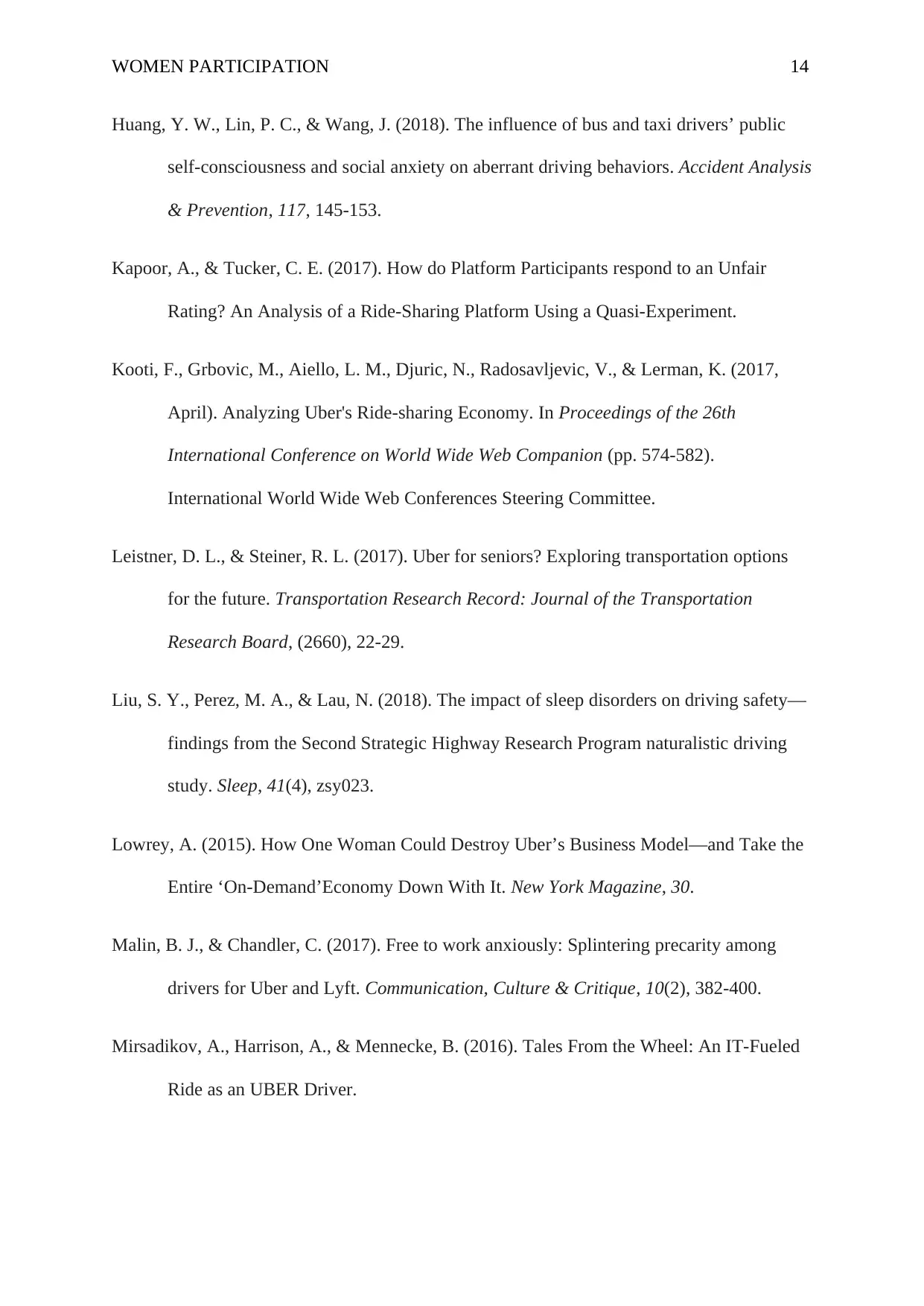
WOMEN PARTICIPATION 14
Huang, Y. W., Lin, P. C., & Wang, J. (2018). The influence of bus and taxi drivers’ public
self-consciousness and social anxiety on aberrant driving behaviors. Accident Analysis
& Prevention, 117, 145-153.
Kapoor, A., & Tucker, C. E. (2017). How do Platform Participants respond to an Unfair
Rating? An Analysis of a Ride-Sharing Platform Using a Quasi-Experiment.
Kooti, F., Grbovic, M., Aiello, L. M., Djuric, N., Radosavljevic, V., & Lerman, K. (2017,
April). Analyzing Uber's Ride-sharing Economy. In Proceedings of the 26th
International Conference on World Wide Web Companion (pp. 574-582).
International World Wide Web Conferences Steering Committee.
Leistner, D. L., & Steiner, R. L. (2017). Uber for seniors? Exploring transportation options
for the future. Transportation Research Record: Journal of the Transportation
Research Board, (2660), 22-29.
Liu, S. Y., Perez, M. A., & Lau, N. (2018). The impact of sleep disorders on driving safety—
findings from the Second Strategic Highway Research Program naturalistic driving
study. Sleep, 41(4), zsy023.
Lowrey, A. (2015). How One Woman Could Destroy Uber’s Business Model—and Take the
Entire ‘On-Demand’Economy Down With It. New York Magazine, 30.
Malin, B. J., & Chandler, C. (2017). Free to work anxiously: Splintering precarity among
drivers for Uber and Lyft. Communication, Culture & Critique, 10(2), 382-400.
Mirsadikov, A., Harrison, A., & Mennecke, B. (2016). Tales From the Wheel: An IT-Fueled
Ride as an UBER Driver.
Huang, Y. W., Lin, P. C., & Wang, J. (2018). The influence of bus and taxi drivers’ public
self-consciousness and social anxiety on aberrant driving behaviors. Accident Analysis
& Prevention, 117, 145-153.
Kapoor, A., & Tucker, C. E. (2017). How do Platform Participants respond to an Unfair
Rating? An Analysis of a Ride-Sharing Platform Using a Quasi-Experiment.
Kooti, F., Grbovic, M., Aiello, L. M., Djuric, N., Radosavljevic, V., & Lerman, K. (2017,
April). Analyzing Uber's Ride-sharing Economy. In Proceedings of the 26th
International Conference on World Wide Web Companion (pp. 574-582).
International World Wide Web Conferences Steering Committee.
Leistner, D. L., & Steiner, R. L. (2017). Uber for seniors? Exploring transportation options
for the future. Transportation Research Record: Journal of the Transportation
Research Board, (2660), 22-29.
Liu, S. Y., Perez, M. A., & Lau, N. (2018). The impact of sleep disorders on driving safety—
findings from the Second Strategic Highway Research Program naturalistic driving
study. Sleep, 41(4), zsy023.
Lowrey, A. (2015). How One Woman Could Destroy Uber’s Business Model—and Take the
Entire ‘On-Demand’Economy Down With It. New York Magazine, 30.
Malin, B. J., & Chandler, C. (2017). Free to work anxiously: Splintering precarity among
drivers for Uber and Lyft. Communication, Culture & Critique, 10(2), 382-400.
Mirsadikov, A., Harrison, A., & Mennecke, B. (2016). Tales From the Wheel: An IT-Fueled
Ride as an UBER Driver.
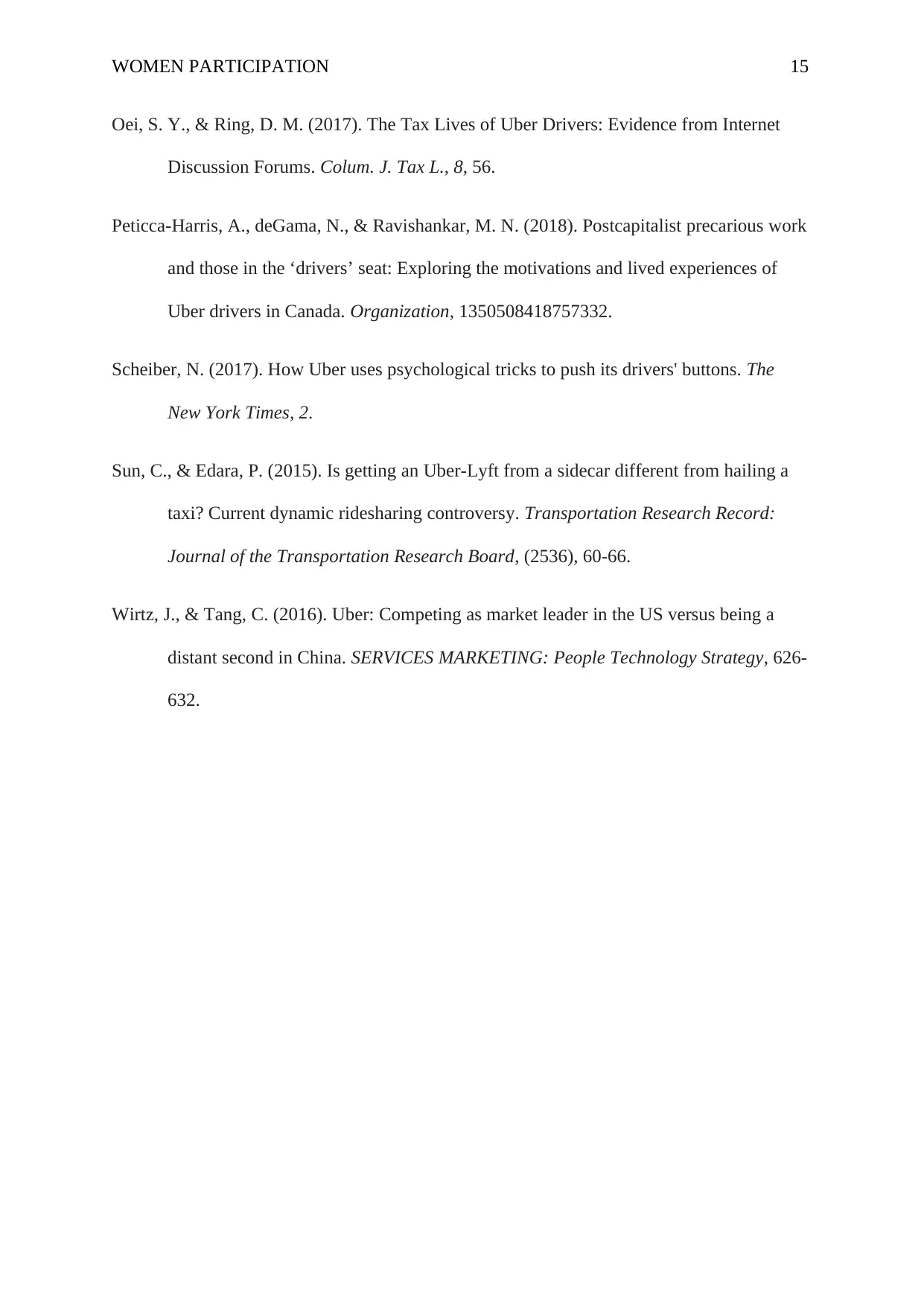
WOMEN PARTICIPATION 15
Oei, S. Y., & Ring, D. M. (2017). The Tax Lives of Uber Drivers: Evidence from Internet
Discussion Forums. Colum. J. Tax L., 8, 56.
Peticca-Harris, A., deGama, N., & Ravishankar, M. N. (2018). Postcapitalist precarious work
and those in the ‘drivers’ seat: Exploring the motivations and lived experiences of
Uber drivers in Canada. Organization, 1350508418757332.
Scheiber, N. (2017). How Uber uses psychological tricks to push its drivers' buttons. The
New York Times, 2.
Sun, C., & Edara, P. (2015). Is getting an Uber-Lyft from a sidecar different from hailing a
taxi? Current dynamic ridesharing controversy. Transportation Research Record:
Journal of the Transportation Research Board, (2536), 60-66.
Wirtz, J., & Tang, C. (2016). Uber: Competing as market leader in the US versus being a
distant second in China. SERVICES MARKETING: People Technology Strategy, 626-
632.
Oei, S. Y., & Ring, D. M. (2017). The Tax Lives of Uber Drivers: Evidence from Internet
Discussion Forums. Colum. J. Tax L., 8, 56.
Peticca-Harris, A., deGama, N., & Ravishankar, M. N. (2018). Postcapitalist precarious work
and those in the ‘drivers’ seat: Exploring the motivations and lived experiences of
Uber drivers in Canada. Organization, 1350508418757332.
Scheiber, N. (2017). How Uber uses psychological tricks to push its drivers' buttons. The
New York Times, 2.
Sun, C., & Edara, P. (2015). Is getting an Uber-Lyft from a sidecar different from hailing a
taxi? Current dynamic ridesharing controversy. Transportation Research Record:
Journal of the Transportation Research Board, (2536), 60-66.
Wirtz, J., & Tang, C. (2016). Uber: Competing as market leader in the US versus being a
distant second in China. SERVICES MARKETING: People Technology Strategy, 626-
632.
1 out of 15
Related Documents
Your All-in-One AI-Powered Toolkit for Academic Success.
+13062052269
info@desklib.com
Available 24*7 on WhatsApp / Email
![[object Object]](/_next/static/media/star-bottom.7253800d.svg)
Unlock your academic potential
© 2024 | Zucol Services PVT LTD | All rights reserved.




